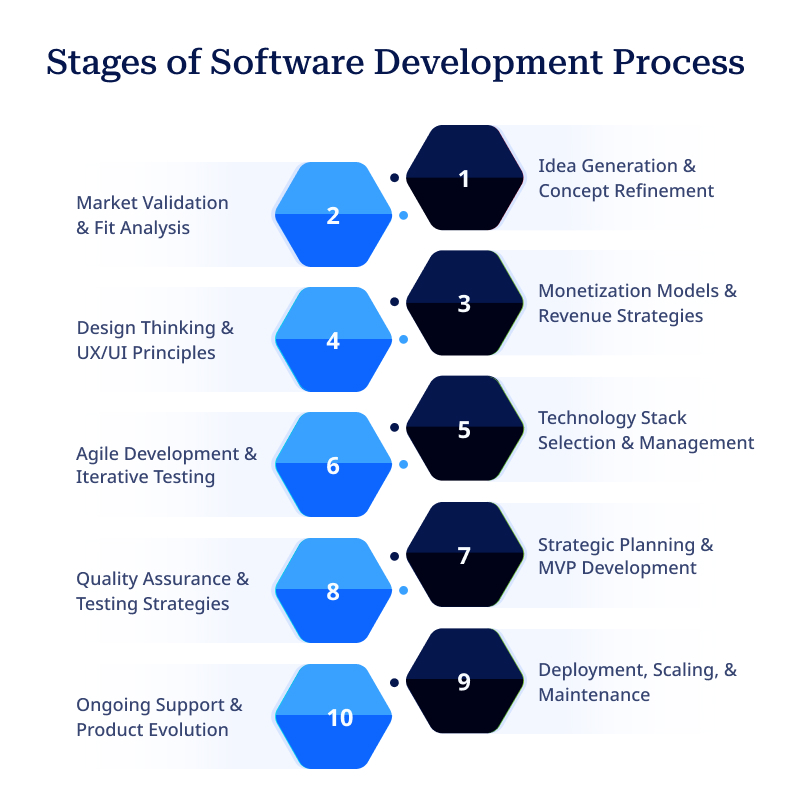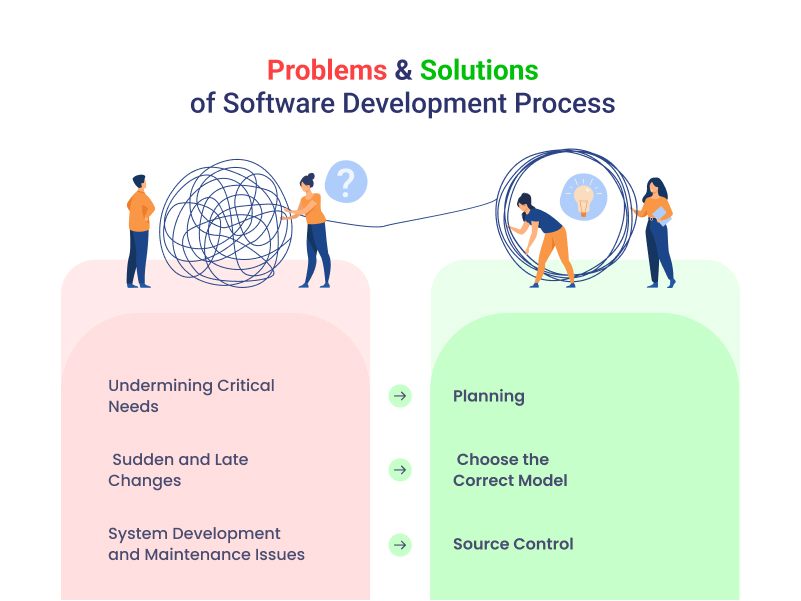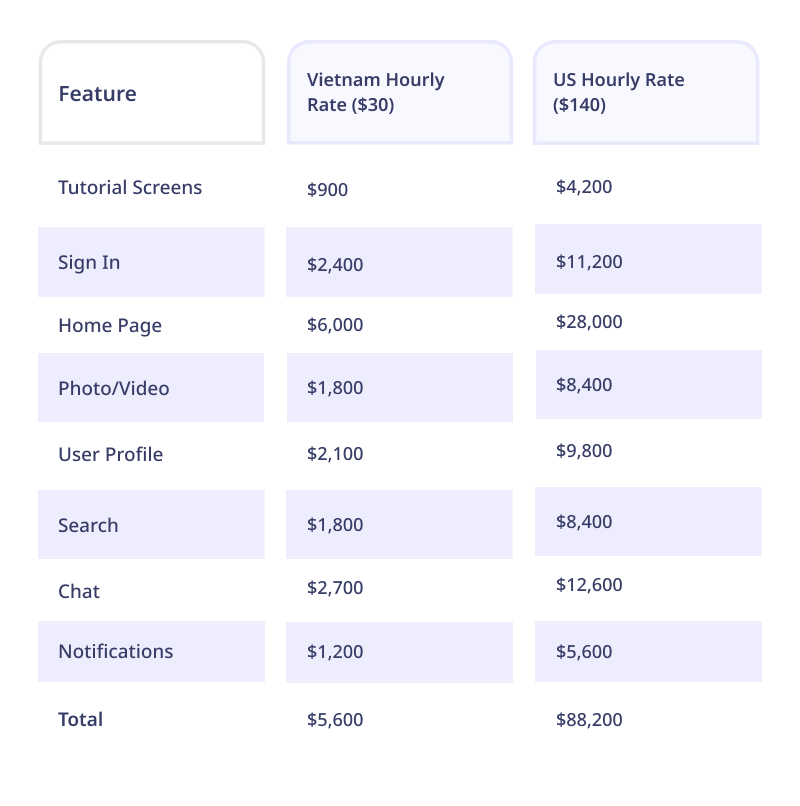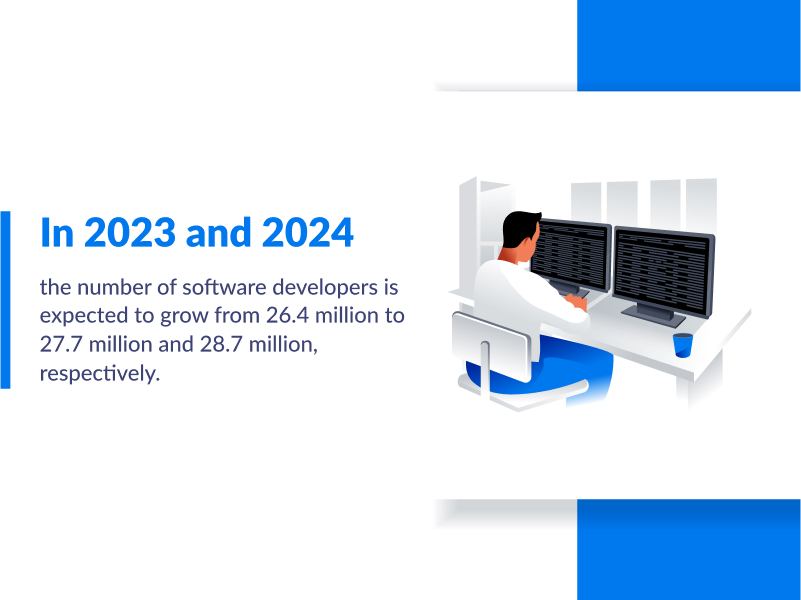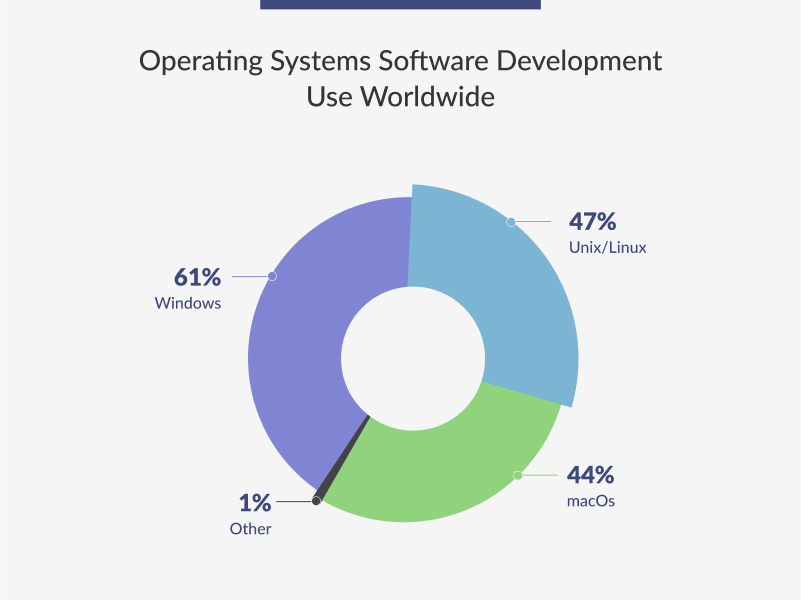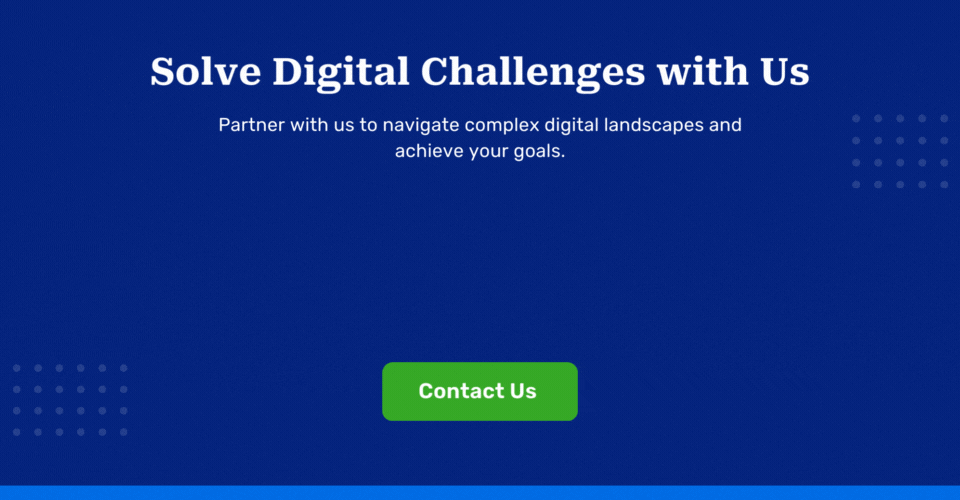Software development has undergone a significant transformation in all these years. With new platforms, new languages, and new tech being developed every day, it is difficult to know where to start when planning out your development strategy.
We have categorized it into five major sections to help you understand the software development process for startups:
- How to start your Software Development Process?
- Software Development Process and its Stages
- Problems and Solutions of Software Development
- Where to Find Software Development Companies?
- Software Development – Market Overview, Cost, Technologies Used
Let’s focus on each in detail.
Also Read: How To Outsource Software Development Effectively
Table of Contents
Why Startups Need Software Development?
Starting a business is exciting, but it’s also a lot of work. You’re probably juggling a million things, from finding customers to managing finances. But one thing that can really help you succeed is having the right software.
Software development for startups is essential for a few key reasons:
- Efficiency: Imagine trying to manage your inventory, track your sales, or communicate with your team without any software. It would be a nightmare! Custom software development for startups can automate these processes, saving you time and money.
- Scalability: As your business grows, you’ll need software that can grow with you. Custom software development for startups allows you to create a system that can handle increasing demands and data without breaking down.
- Competitive Advantage: In today’s market, having the right software can give you a competitive edge. You can create unique features or streamline your operations in ways that your competitors can’t.
Think about these business scenarios:
- An eCommerce store: You need a robust platform to handle orders, manage inventory, and process payments securely.
- A food delivery service: You need software to track orders, manage deliveries, and communicate with drivers.
- A marketing agency: You need a system to track leads, manage campaigns, and analyze results.
If you’re thinking about starting a business, don’t underestimate the power of software development. It’s an investment that can pay off big time, helping you achieve your goals and stand out from the competition.
Want to learn more about different approaches to building software? Check out our blog post on software development models to explore the options.
Software development is a broad field, with many different approaches to building applications. The type of software development you choose depends on your project’s needs and goals.
Here are some common types of software development:
- Web Development: Creating websites and web applications.
- Mobile App Development: Building apps for smartphones and tablets.
- Desktop Application Development: Creating software for computers.
- Game Development: Developing video games.
- Embedded Software Development: Creating software for devices like medical equipment, cars, and appliances.
- Cloud Computing: Developing software for cloud-based services.
- Data Science & Machine Learning: Building software that analyzes data and predicts outcomes.
Hiring a dedicated development team can give you the focused expertise and consistent support you need to bring your software project to life.
Also Read: Outsourcing Software Development to India – Why it is the Preferred Centre for Outsourcing?
Software Development Process and Its Stages
Launching a successful software product requires a well-defined plan and a clear understanding of the development process. For startups, navigating this journey can be particularly exciting and challenging, with limited resources and a lot of ambition. Let’s break down the key stages of software development life cycle for startups:
1. Idea Generation & Concept Refinement
This is where it all begins – the spark of an idea that can change the world! This stage involves brainstorming and shaping your core concept into a solid foundation for your product. It involves:
- Brainstorming Sessions: Gather your team and encourage open, creative thinking. Let ideas flow freely, even if they seem outlandish at first. You never know what unexpected brilliance might emerge!
- Market and Feasibility Studies: Do your research! Is there a real market for your idea? Is it viable and scalable? Conduct market research and feasibility studies to assess the potential of your concept.
- Selection and Refinement: It’s time to get down to business. Review all the ideas you generated and narrow them down based on potential impact, feasibility, and alignment with your overall vision. Refine your chosen concept into a clear and actionable plan.
2. Market Validation & Fit Analysis
Now that you have a strong concept, it’s time to make sure it resonates with your target market. This phase involves validating your product idea with potential users and refining it based on their feedback.
The software development good practices in this step include :
Market Research: Dive deep into your target market. Conduct surveys, focus groups, and in-depth market analysis to understand customer needs, preferences, and pain points.
Competitor Analysis: Study the competition thoroughly. What are they doing well? Where are there gaps in the market? Identify opportunities for differentiation and create a unique selling proposition for your product.
Customer Feedback: Engage with potential customers! Conduct interviews, run pilot tests, and gather feedback on your product concept. Use these insights to refine your product and make sure it meets the real needs of your target audience.
3. Monetization Models & Revenue Strategies
It’s time to figure out how you’re going to make money! Choosing the right monetization strategy is critical for the financial success of your software.
Monetization Options –
- In-app Purchases: This works well for apps like games or utility tools, where users can buy additional features, functionalities, or virtual goods.
- Paid Subscription: Offer a recurring subscription for access to premium content or features. This model provides a steady stream of revenue and is perfect for apps that offer ongoing value.
- Sponsorship: Partner with brands who align with your target market. They pay to have their content or advertisements integrated into your app.
- Freemium Model: Offer basic features for free, then charge for advanced features or add-ons. This can help you attract a larger user base and convert them into paying customers.
- Advertising: Incorporate ads into your app. This can be a good revenue source, especially for apps with a large user base.
4. Design Thinking & UX/UI Principles
First impressions matter, and a great user experience can make or break your software. This phase focuses on designing an interface that is both user-friendly and visually appealing.
The steps include:
- User-Centered Design: Always remember who you’re designing for! Emphasize understanding your users’ needs and behaviors to create intuitive and accessible designs.
- Consistency and Simplicity: Use a consistent design language throughout your app. Keep things simple and easy to navigate, so users can easily find what they need.
- Responsive Design: Ensure your app works flawlessly on all devices, from desktops to smartphones.
- Accessibility Features: Design with inclusivity in mind. Make sure your app is accessible for people with disabilities.
5. Technology Stack Selection & Management
Choosing the right technology stack is a crucial decision that can impact your product’s scalability, maintainability, and overall cost. The steps to select the right one are:
- Scalability and Flexibility: Select technologies that can grow with your business. Consider cloud services like AWS or Azure, which offer scalable infrastructure.
- Security and Reliability: Security is paramount. Select technologies known for their security features and reliability.
- Cost-Effectiveness: Evaluate the cost implications of different technologies, considering both initial investment and long-term maintenance expenses. Open-source databases, for example, can offer a cost-effective alternative to proprietary solutions.
- Cross-Platform Development: If you want to reach a wider audience, consider technologies that allow you to build apps for multiple platforms.
We offer reliable software consulting services to help businesses make informed decisions about technology needs.
6. Agile Development & Iterative Testing
Agile methodologies are perfect for startups, allowing you to be flexible and adapt to changing market conditions and user feedback.
The action steps are:
- Sprint Planning: Organize development into short sprints, focusing on delivering specific features or improvements. This allows for frequent reassessments and adjustments to ensure you’re on the right track.
- Continuous Integration and Deployment (CI/CD): Automate testing and deployment processes to speed up development and reduce the risk of errors.
- User Testing and Feedback Loops: Get your software in front of real users and gather feedback. This helps you refine your product and make sure it meets the needs of your target audience.
Discover how Agile software development can help your project be more flexible and responsive in our blog post on the benefits of Agile software development.
7. Strategic Planning & MVP Development
Before you dive into full-blown development, it’s smart to create a Minimum Viable Product (MVP). This is a stripped-down version of your software that has just enough features to attract users and get feedback. It includes:
- Goal Setting and Roadmap Development: Define your goals for your MVP, and create a roadmap outlining key milestones and timelines for development.
- Lean Development Practices: Focus on building the core functionalities that address your target audience’s primary needs.
- Feedback and Iteration: Launch your MVP, gather feedback, and use it to improve your product.
Building your dream software project requires skilled hands, so you can consider hiring software developers who can bring your vision to life.
8. Quality Assurance & Testing Strategies
You’ve put a lot of effort into building your software. Now, it’s time to make sure it works perfectly! Quality assurance is crucial for ensuring that your software meets the necessary standards before it reaches your users.
Test Plan Development: Create a comprehensive plan that covers all aspects of your software, including functionality, usability, security, and performance.
Automated Testing: Automate your testing process to speed up development and ensure thorough coverage.
User Acceptance Testing (UAT): Get your target users to test your software and provide feedback before release.
9. Deployment, Scaling, & Maintenance
Your software is ready to launch! But it’s not just about getting it out there; it’s about ensuring it can handle the demands of your users and keep running smoothly over time.
- Deployment Automation: Automate the deployment process to ensure a smooth and reliable transition from development to production.
- Scalability Planning: Make sure your infrastructure can handle growth. Utilize cloud services to scale your platform as needed.
- Ongoing Maintenance: Establish a process for monitoring and maintaining your software, addressing new security vulnerabilities and fixing any issues that may arise.
10. Sustaining Success – Ongoing Support & Product Evolution
Congratulations, your software is live! But your journey doesn’t end there. It’s crucial to provide ongoing support to your users, gather feedback, and constantly evolve your product.
- Customer Support Framework: Set up a system for handling user inquiries and resolving issues quickly and efficiently.
- Continuous Feedback Loop: Gather feedback from your users and use it to make improvements and updates.
- Evolution and Expansion: Keep an eye on technology trends and market shifts to ensure your product remains relevant and competitive.
Boost your project success with proven strategies for software development. Learn about common approaches and best practices in our blog.
Start your software development journey today.
Problems & Solutions of Software Development Process
As a startup, you likely do not have the luxury of a large team or expansive budget regarding software development. That does not mean you cannot create a great product. You can develop software that meets your needs and budget with careful planning and execution.
But mere development of the software does not guarantee success. Many problems and concerns arise in every undertaking, especially in the highly analytical and mathematical tech sector. Here are some issues and their solutions to help you in your software development process:
| Cases | Problem | Solution |
| Case 1 | Undermining Critical Needs: Teams are overfocused on the end product and forget what’s important |
Planning: To avoid this problem, the team should plan and analyze the crucial points during the initial stage.
|
| Case 2 | Sudden and Late Changes: The sudden and last-moment adjustments may disrupt the project flow. |
Choose the Correct Model: The Agile and Scrum model allows teams to pause the overall ongoing process. Teams can always revisit each stage as per the requirement.
|
| Case 3 | System Development and Maintenance Issues: Avoiding system, development, and coding challenges are impossible. That’s why teams should use standard IT solutions. |
Source Control: The teams must have a central repository for source control where they keep the important codes. They can always return to source control if a server faces issues or fails.
|
Also Read: Software Development – Cost, Features, and Security Measures
Tips for Fast Software Development for Startups
In the fast-paced world of startups, getting your software product to market quickly can be the difference between success and getting beat by the competition. But how do you balance speed with quality when building custom software?
Here are some key tips for accelerating your software development process without sacrificing quality:
-
Focus on the MVP (Minimum Viable Product)
Don’t try to build everything at once. Start with the core features that address your target audience’s most critical needs. This “minimum viable product” allows you to gather valuable user feedback early on and iterate quickly based on real-world data.
-
Prioritize Ruthlessly
With an MVP, prioritize features ruthlessly. Ask yourself: “Is this feature absolutely essential to launch?” Focus on building core functionality first, then add bells and whistles later based on user feedback.
-
Agile Development
Traditional software development methods can be slow and cumbersome. Agile methodologies, like Scrum, break down development into short sprints with frequent testing and feedback loops. This allows you to adapt quickly and course-correct as needed.
-
Use Existing Tools and Resources
Don’t reinvent the wheel! There are tons of pre-built software tools and libraries available that can save you time and effort. Utilize these resources to streamline your development process.
-
Automate Where Possible
Automate repetitive tasks like testing and deployment to free up your development team to focus on more strategic work. This can significantly speed up your development process.
Also Read: Automation in Software Development- A New Stream of Revolution
Breaking Down Software Development Costs for Startups
Software development can be an investment, and the cost can vary a lot depending on what you want to build. A simple app might cost you around $50,000, while a more complex one could easily go up to $250,000.
Here are a few things that influence the price:
- How complicated the app is: A basic website is usually cheaper to build than a super fancy app that works on phones and computers.
- The design: If you want a really cool and unique design, it’ll take more time and expertise, so it’ll cost more.
The extra work will add to the cost if you need to connect it to other systems.
The biggest part of the cost is usually the people who build the software. If you hire your own team, you’ll need to pay salaries, benefits, and office space and equipment.
Where you build your software can also make a big difference in the cost. For example, hiring a software developer in the United States can cost around $8,500 per month on average. That’s a lot of money!
To save money, many startups choose to outsource their development work. This means they hire a team in another country to build their software. Places like Vietnam in Southeast Asia are popular for outsourcing because the costs are lower, but the quality of work is still great.
Software Development – Market Overview, Cost, & Technologies Used
Software Development is a rapidly growing industry expected to grow as more companies shift to virtual environments. Improving customer experiences, bringing more feature-rich and innovative products to market, and implementing new revenue and cost-saving opportunities are essential. Here are some fascinating software development statistics, trends and insights to demonstrate the sector’s growth and how it is the economy.
Elevate your software development journey to bring your vision to life
Market Overview
What size is the market for software development? What awaits us in the future? How many software engineers exist worldwide? In this section, we’ll discuss some frequently asked topics about the software development industry and examine its prospects for the future.
- Custom software development market size was valued at USD 28.2 billion in 2022 and is estimated to register a CAGR of over 21.5% between 2023 and 2032.
- In 2023, the North American custom software development market held the largest global revenue share of 32.55%. Moreover, with the surge in automation and digital transformation, North America is becoming the preferred destination for custom software development services.
- Europe’s custom software development market is booming, with experts predicting it will grow by a significant 23% each year between 2024 and 2030. This growth is fueled by many European companies coming up with cutting-edge solutions to meet the needs of different industries. For example, in December 2023, Nokia announced that their new 5G software was picked by a Finnish company, Telia, as part of a program funded by the European Union.
- In 2019, there were 26.4 million software developers worldwide. By 2023, the number is projected to increase to 27.7 million, and by 2024, to 28.7 million.
Explore the exciting world of Machine Learning and its impact on software development in our blog post on Machine Learning in software development.
Explore our recommendations to connect with top software development experts now.
Technologies Used in Software Development
Businesses investing in software and developers have over 700 programming languages to choose from. Here are some of the tools used in software development for startups.
- As per the most recent stats of Statista, the most common environment for 61% of software developers is Windows
- With 47% of developers using it, Linux is in second place on the list of the most used PC operating systems, followed by macOS
- The most popular programming languages are JavaScript, Python, Java, C#, and PHP
- As of 2020, MySQL is developers’ most widely used database system
- The top three web frameworks are jQuery, React.js, and Angular
- One of the essential software development tools is regarded as being GitHub
- Python is one of the fastest-growing programming languages
Also Read: Best 12 Countries to Outsource Software Development
Takeaway
We now know that before starting your software development process, it is crucial to understand what you need clearly. A proper software development plan for startups can help save time and money.
We have provided you with this guide to ensure that you start your software development with the necessary knowledge and expertise. Software development can be different for different businesses. There are many factors that lead to the success of software development for startups since each project involves different stages, hidden pitfalls and different choices.
Remember to consult with PixelCrayons, the custom software development company and take advantage of the above-stated resources. Your startup can thrive with continuous hard work and dedication.

